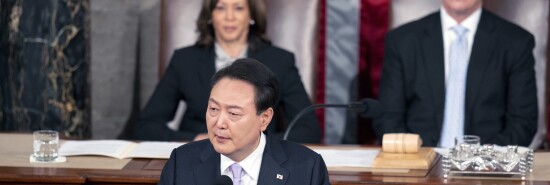
Decoding South Korea’s nuclear-focused state visit
Daniel DePetris
Video Embed
President Yoon Suk-yeol’s state visit to the United States, the first by a South Korean president in 12 years, was nothing short of a lovefest.
But in between the fine dining and the sight of tuxedoed Yoon performing the 1970s classic “American Pie” were weighty issues. These included discussions about the war in Ukraine, North Korea’s nuclear weapons and missile programs, and geopolitical complications associated with China. And while the U.S.-South Korea alliance may be “ironclad” in public, no two allies have identical security interests or ways of looking at the world.
CHINA CLAIMS US NUCLEAR SUBMARINE IN SOUTH KOREA ‘SOURCE OF TENSION’ IN REGION
Take Ukraine. Both nations have condemned Russia’s invasion, but when it comes to military support to Ukraine, the two allies diverge. In contrast to the U.S., South Korea has avoided sending military aid of any kind directly to the Ukrainians. Seoul prefers to focus on financial and humanitarian support. Although Yoon has opened the door to providing military aid at some point in the future, he is trying to thread the needle between staying on the same page as its biggest ally, the U.S., but being careful to preserve a functioning relationship with Moscow.
The most immediate item on President Joe Biden and Yoon’s agenda, however, was North Korea’s nuclear weapons program. The core ingredient is old-fashioned deterrence, making it obvious to the North Koreans that any attack on South Korea would be met with an overwhelming U.S.-South Korean military response. This trip was all about putting America’s nuclear weapons arsenal more publicly into the mix. As North Korea’s nuclear and missile programs have become more diverse and capable, Seoul has increasingly questioned whether Washington would really come to its defense if Pyongyang might respond to any U.S. intervention with a nuclear-armed intercontinental ballistic missile strike on the U.S. homeland. In turn, attaining an independent nuclear weapons capability has gotten more mainstream in Seoul; Yoon himself publicly surmised during an interview in January that it may be time for Seoul to consider building its own bomb.
This isn’t something Biden wants. To convince Yoon that a South Korean bomb isn’t necessary, Biden provided him with the so-called Washington Declaration. The declaration states that “President Biden reaffirmed that the United States’ commitment to the ROK [South Korea] and the Korean people is enduring and ironclad, and that any nuclear attack by the DPRK against the ROK will be met with a swift, overwhelming and decisive response.”
Nuclear-capable U.S. bomber aircraft will make more frequent visits to South Korea. More importantly, nuclear-armed ballistic missile submarines will also start making port calls in South Korea for the first time since the end of the Cold War. Seoul will also become an active participant in U.S. deliberations regarding the prospective use of nuclear weapons on the Korean Peninsula.
All of this activity is designed to reassure the South Koreans that the extended deterrence concept is alive and well. None of it, however, is likely to compel a change in North Korea’s own nuclear policy. If anything, U.S. attempts to assure South Korea via more large-scale drills and fighter-bomber deployments will have the counterproductive effect of forcing North Korean leader Kim Jong Un to triple down on nuclear weapons as a regime survival tactic.
CLICK HERE TO READ MORE FROM THE WASHINGTON EXAMINER
Daniel DePetris (@DanDePetris) is a contributor to the Washington Examiner’s Beltway Confidential blog. His opinions are his own.
